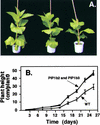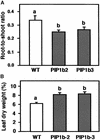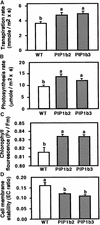Overexpression of a plasma membrane aquaporin in transgenic tobacco improves plant vigor under favorable growth conditions but not under drought or salt stress
- PMID: 12566583
- PMCID: PMC141212
- DOI: 10.1105/tpc.009225
Overexpression of a plasma membrane aquaporin in transgenic tobacco improves plant vigor under favorable growth conditions but not under drought or salt stress
Abstract
Most of the symplastic water transport in plants occurs via aquaporins, but the extent to which aquaporins contribute to plant water status under favorable growth conditions and abiotic stress is not clear. To address this issue, we constitutively overexpressed the Arabidopsis plasma membrane aquaporin, PIP1b, in transgenic tobacco plants. Under favorable growth conditions, PIP1b overexpression significantly increased plant growth rate, transpiration rate, stomatal density, and photosynthetic efficiency. By contrast, PIP1b overexpression had no beneficial effect under salt stress, whereas during drought stress it had a negative effect, causing faster wilting. Our results suggest that symplastic water transport via plasma membrane aquaporins represents a limiting factor for plant growth and vigor under favorable conditions and that even fully irrigated plants face limited water transportation. By contrast, enhanced symplastic water transport via plasma membrane aquaporins may not have any beneficial effect under salt stress, and it has a deleterious effect during drought stress.
Figures







References
-
- Agre, P., Sasaki, S., and Chrispeels, M.J. (1993). Aquaporins: A family of water channels proteins. Am. J. Physiol. 265, F461. - PubMed
-
- Amodeo, G., Dorr, R., Vallejo, A., Stuka, M., and Parisi, M. (1999). Radial and axial water transport in the sugar beet storage root. J. Exp. Bot. 50, 509–516.
-
- Blum, A., and Adelina, E. (1979). Cell membrane stability as measure of drought and heat tolerance in wheat. Crop Sci. 21, 43–47.
-
- Blumwald, E. (2000). Sodium transport and salt tolerance in plants. Curr. Opin. Cell Biol. 12, 431–434. - PubMed
Publication types
MeSH terms
Substances
LinkOut - more resources
Full Text Sources
Other Literature Sources
Molecular Biology Databases

